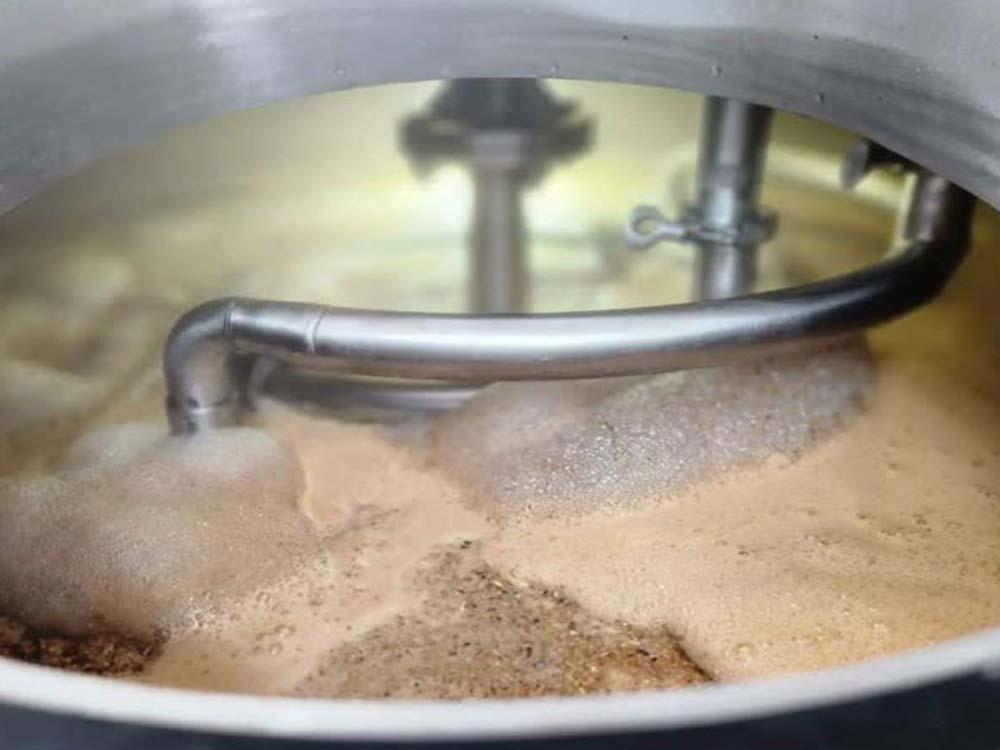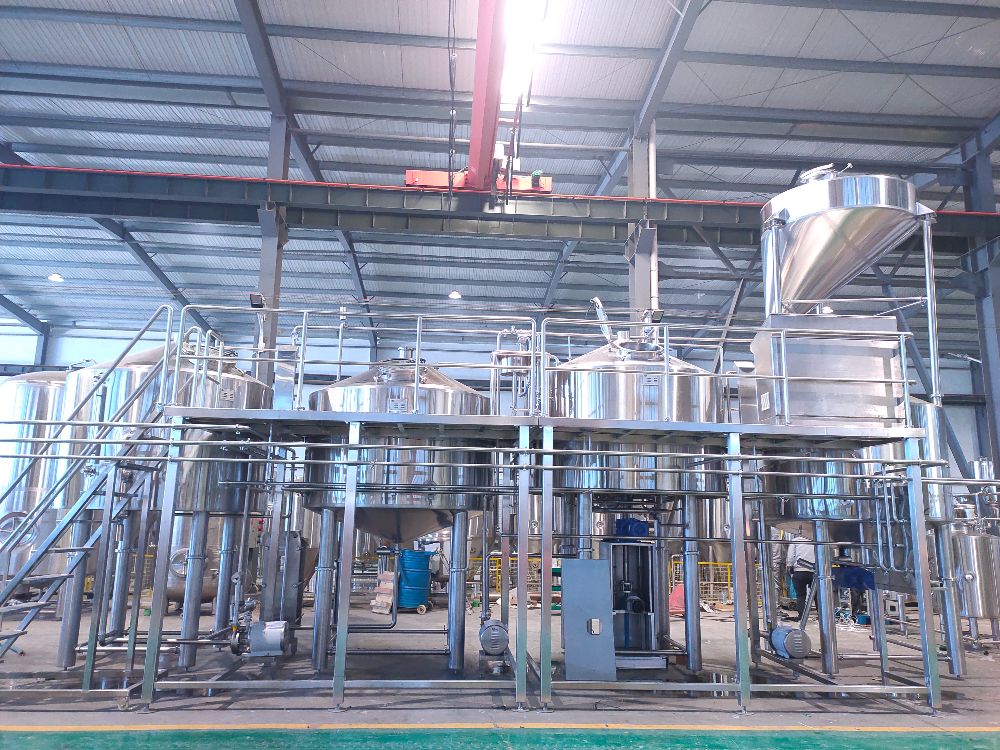The brewery carries out the key step in brewing: Mashing
- Jan 23, 2025
- 191
- tiantai
The process of mashing, which occurs within a brewhouse, involves mixing malt and auxiliary materials with water in a mashing tun. During this process, various enzymes contained in the malt are activated under suitable conditions to thoroughly leach the extractables from the malt. This process is integral to the operation of brewery equipment. Technically, mashing begins during the malting phase. The dissolved components extracted from malt and adjuncts are referred to as extractum. The unfiltered solution produced by mashing is called mash, while the filtered and clarified liquid is known as wort.
Purpose and requirement of brewhouse
I.Overall goals:
Optimal wort composition; High leaching rate; Improve the utilization rate of raw materials;Reduce energy consumption;
II. Process objective
Good filtration; Primary and post-fermentation fermentation is rapid; Conducive to yeast settlement; Good beer stability
III. Numerical object
Light chroma; Beer is very reductive; Good taste stability;
IV. Main influence factors
Malt quality; Good crushing; The adjustment of temperature, time, PH value optimizes the optimal conditions for enzyme action.
Changes of the main substances in the mashing process
I. Starch decomposition:
The breakdown of starch is an important enzymatic reaction in the process of mashing, which can be divided into three continuous irreversible processes: gelatinization, liquefaction and mashing. Among them, amylase can be decomposed well after starch gelatinization, but the decomposition of ungelatinized starch takes a long time.
II. Test method for starch decomposition:
Generally, iodine solution is used to check whether the starch decomposition is complete. A little mash is dropped on the white porcelain plate, and then a drop of iodine is added to observe whether there is a color reaction. It should be noted that the mash sample must be cooled before testing.
III. Factors affecting starch decomposition:
Malt variety and quality: Usually the enzyme content of light malt is higher than that of dark malt, and the wort produced has more sugar and less dextrin. Dark malt contains less enzyme, slow mashing and more dextrin.
IV. Decomposition of protein:
The products of its breakdown are not only fermented nutrients, but also affect beer flavor, foam and abiotic stability.
V. Decomposition of β- glucan:
Proper decomposition of the substance is the main component of the beer body and foam properties, and excessive will easily lead to filtration difficulties.
VI. Decomposition of polyphenols:
On the one hand, polyphenols are easy to oxidize, which will increase the color of wort, make beer bitter and rough, and produce bitter; On the other hand, some polyphenols coagulated with proteins during mashing and wort boiling, which was beneficial to improve the abiotic stability of beer.
The technological conditions of brewhouse:
I. Raw materials and auxiliary materials
The difference in raw materials and auxiliary materials (especially malt) determines the difference in mash feeding temperature.
If the malt is not dissolved enough, the feeding temperature should be selected at 35 degrees, which is conducive to the leaching of enzymes and the beer foam is better; If the malt dissolves well, the feeding temperature should be selected at 50 degrees, but it should not be rested at 50 degrees for a long time, which will lead to too much protein being decomposed, the beer taste is too thin, and the brewing capacity is poor.
II. The effect of feeding temperature on beer quality
The unloading temperature influences the composition of the wort and beer, the foaming, the filtration performance and the taste stability.
The more concentrated the mash, the higher the temperature stability of the enzyme, but the lower the reaction rate;
When the concentration of mash is 8~16 Plato, it basically does not affect the action of various enzymes, and once the concentration exceeds 16 Plato, the effect of enzymes gradually slows down. Therefore, the light beer should be controlled within 16 Plato, and the first wort concentration of the strong beer can be appropriately increased to 18-20 Plato;
If the mash is too concentrated or too thin, it will affect the yield of the extractable. The mash is too thick, and the residual sugar is high, which affects the yield of extracts. The mash is too thin, and the washing residue is not cleaned with less water, which also affects the yield of the extractable;
The optimal PH value of various major enzymes in malt is generally lower than that of mash, so the PH value of mash is often adjusted to about 5.4~5.6.
III. Mixing of malt grind with mash water
When mashing and feeding, the malt powder should be fully mixed with water, and it must not be agglomerated to make the enzyme reaction complete. There are two ways to mix wheat water.
The traditional way is to put the water in the mash tank, adjust the water temperature, start the stirrer, and slowly send the malt powder through the conveyor drum to the mash tank, and stir while mixing to prevent agglomeration. However, this method will result in the loss of malt powder, and the mash will absorb oxygen, which is not good for the quality of the beer;Using the hydrator, the mash water is sprayed out in the form of water mist, and the malt powder passes through the water mist area from top to bottom, and then mixes evenly and then enters the mash tank, which will not cause the malt powder to fly and agglomerate.

Why choose a professional brewhouse?
I. Efficient and precise
Modern mashing equipment is equipped with an intelligent control system, which can accurately control the temperature and time of mashing to ensure the efficient completion of starch transformation. The multi-stage brewhouse process can be adapted to the needs of different beer styles, such as light, strong or special flavors.
II. Energy saving and environmental protection
Innovative heat recovery technology significantly reduces energy consumption. At the same time, the equipment uses food-grade stainless steel materials to ensure the safety and hygiene of the brewing process.
III. Multi-functional integration
Our brewhouse equipment not only includes a brewhouse, but also integrates functions such as filtration, boiling and spinning, which greatly simplifies the operation. The modular design is more suitable for small and medium-sized breweries or craft brewers, allowing for flexible scaling up of production.
IV. Ease of Maintenance
Designed for high-frequency use, the equipment is simple to clean, easy to clean and maintain, reducing downtime and saving brewers time and money.
Whether you're a start-up brewery or an industry leader looking to expand your production capacity, we offer tailor-made brewhouse solutions featuring advanced brewery equipment, including state-of-the-art mashing tun designed to meet your specific needs. We provide a one-stop service, from beer equipment design, installation, and commissioning to technical training, ensuring your brewing journey is smooth and successful.
Make brewing easier and beer more exciting!
Contact us to start your craft brewing chapter today!
Edited by Amanda
Sales manager | Tiantai beer equipment
Email: [email protected]



.jpg)
